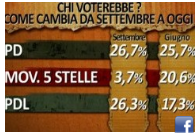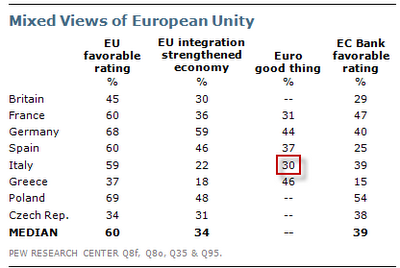For us, there are two ways to split the euro zone in two parts, either unilateral exists or the introduction of the Northern Euro. With this currency, people in the Northern states would finally consume more. See here our analysis why the Northern Euro will needed against global and European trade imbalances and against excessive austerity in Southern Europe.
First proposal: Unilateral exits: Is Italy leaving the euro?
 One way is unilateral exits as Italy may do after the next elecions. The “technical” prime minister Monti is supposed to govern only till Spring 2013 or even earlier. Currently the anti-euro movement “5 Stelle” would obtain 20.6% in elections, Berlusconi’s PDL 17.3%. The pro-Euro left-wing party gets 25.7%. (Other voters undecided). This result would probably give an anti-euro majority.
One way is unilateral exits as Italy may do after the next elecions. The “technical” prime minister Monti is supposed to govern only till Spring 2013 or even earlier. Currently the anti-euro movement “5 Stelle” would obtain 20.6% in elections, Berlusconi’s PDL 17.3%. The pro-Euro left-wing party gets 25.7%. (Other voters undecided). This result would probably give an anti-euro majority.
The main author of this blog speaks Italian and lived in Italy a long time. Italians are since the beginning are not happy with the euro, many think that prices doubled due to the euro, but salaries remained the same. In Germany this attitude was initially the same, but vanished with the time when prices became relatively cheaper. In Italy this internal opposition against the euro did never go away, consumer prices kept rising and are now as high as in Germany, but salaries are half or even less.
Italy is effectively the country which is most opposed to the euro (source). Recent data even shows that 45% of Italians want to return to the lira.

The full detail on a potential Italian euro exit can be found here.
We admit that an exit of a euro member might trigger irrational behaviors and bank-runs. By the beginning of 2013 however, QE3 and the ECB’s OMT operation have eliminated tail risks and risk aversion. Therefore we see upcoming inflation in the Northern European countries, while Southern Europe will need to adjust salaries downwards.
In this scenario we propose a second solution.
Second proposal: Step-by-step creation of the Northern Euro
Our proposal is a reasonably slow process of a Northern Euro creation, where small countries like Finland or the Netherlands would exit the euro first and build up the Northern Euro together with the later joining Germany. Only the problem countries would remain in the (Southern, the existing) euro. After initial inflation they will then take profit of a strong devaluation, make their exports competitive and allow for their own monetary and fiscal policy. Similarly to the Swiss economy that expanded despite a rising franc thanks to cheaper prices and strong consumer spending, the German economy will stay competitive even with a strong Northern Euro, provided that the Northern Euro does not appreciate too quickly.
As compared to the southern countries, that rely more on labor, Germany’s exports have a bigger capital and technology part, for which prices do not increase with a stronger currency, technology and capital becomes cheaper. Therefore Germany will not suffer if the appreciation of the Northern Euro is only gradually.
Central Banks of Northern and Southern Euro will need to adopt the SNB approach
For us the SNB will implement a crawling peg from 2014 or 2015 (which year depends on the state of the global economy). We think that the Swiss will allow a franc appreciation per year by about 2%. This means that the minimum rate of the EUR/CHF will be 1.18 e.g. in 2014, 1.12 in 2015, etc.
Similarly to the EUR/CHF peg of the Swiss National Bank (SNB), both central banks of the Northern Euro and the Southern Euro will need to work together to prevent a sudden appreciation of the Northern Euro, especially later when Germany joins it. A rise of more than 10% per year against the Southern Euro should not be allowed. Similarly as the ECB euro purchases in the year 2001 (see next chapter) or the ones of the SNB, the Northern Euro Central Bank (NECB) will be obliged to purchase (Southern) euros to limit the appreciation of its (Northern) currency.
Currency purchases of the Northern European Central Bank will replace potential huge Bundesbank losses on Target2 and on ESM and EFSF by the Northern states. Similarly as the Swiss, the NECB will need to realize certain losses, which however will be limited by the restrictions on bond purchases.
Restrictions on government bond purchases and redemptions
Purchases of government bonds of Northern European countries shall be restricted to domestic buyers. New issues of government bonds shall be redeemed only by domestic holders. Old issues remain valid in order to prevent a “technical default” of German and other Northern European countries. Rating agencies might declare bonds of Germany and the other Northern countries as defaulted.
Despite this thread, the Northern European government should consider paying back existing issues only in (Southern, old) euros and changing the local law for it. English law bonds will probably require the re-denomination from (Southern) euros into Northern euros.
The retro-perspective from the year 2030
We have created a hypothetical retroperspective from the year 2030, but we are quite sure that the euro will not survive the year 2020 without the exit of at least 2 members (not only Greece…).
Both euro exit solutions might be once-off painful, but they will prevent endless transfer payments from the north to the south, something we see inside Italy for centuries, where the north pays for the south.
The advantages are obvious: The two zones are a lot more than the old euro an optimum currency area. Companies will only need to look at exchange rates only when they switch zones (vs. the old pro-euro argument).
Better to split the Euro zone in two instead of an endless euro delirium and transfers into the Southern countries, who will never make it.
Some more ideas about the Northern euro introduction
“Czech, German Leaders Daydream About Northern Euro.” Wall Street Journal, December 13, 2010.
“It’s (Long Past) Time for a ‘Northern’ Euro” by Andrew Stuttaford. National Review, July 18, 2011.
“Break-up of the euro could usher in a welcome new dawn for Europe” by Roger Bootle. The Telegraph, September 14, 2011.
“Germany needs to resist the euro’s sweet-smelling poison” by Hans-Olaf Henkel. The Guardian, March 13, 2011.
“’Super Sad’ And Satiric, Two Stories Of Doomed Love” by Michael Schaub (review). NPR.org, July 8, 2010.
Wolfson Prize
The maybe best ideas come from the Wolfson Prize, still they do not focus on the Northern Euro, but on an orderly break-up of the euro.
and the winner:
Jens Nordvig – Planning for an orderly break-up of the European Monetary Union
See more for
















5 comments
Skip to comment form ↓
Mevo
2012-06-27 at 09:39 (UTC 2) Link to this comment
It is probably obvious for everybody that maintaining the floor is costly and will cost more, the more it lasts… Stop or continue are both causing some serious troubles. If you think about it, there would be a third (scary) alternative: That Switzerland join the EURO.
And what’s crazy is that, the longer this PEG lasts and the EURO sinks, the more probability this scenario slowly gets. Because it “solves” both problems of the “continue” and “stop”…
As mad as it could sound, ever thought about this ?
2012-06-28 at 00:08 (UTC 2) Link to this comment
It is surely valid to discuss that Switzerland joins the euro in order to make the peg official and stop inflows in the country. However it will face the same peg costs, Germany has, when pegging the “German” euro to the “PIIGS” euro. In the case of a split up of the euro zone, Target2 and ESM/EFSF, et. al. unrealized losses will finally be realized, when some more PIIGS countries will go insolvent and/or pay back only in less valued “Southern euros”. We will discuss this in “Is the SNB prepared for the black swan”.
Lorne Henderson
2012-08-24 at 00:22 (UTC 2) Link to this comment
My chart analysis reveals that the NEW (Northern) Euro will include these countries: Germany, Switzerland, Netherlands, Sweden, Denmark, Finland, U.K, and maybe Norway. The Dax will rise to over 10k and and the new currency will be eventually be worth 2.25 USD.
George Dorgan
2012-08-24 at 13:17 (UTC 2) Link to this comment
Thank you. This is certainly a “very Northern” euro.
I assume that Austria, Estonia and Slovakia which corporate very strongly with Germany (see the post on German export model) will be also part of it.
Belgium and Luxembourg are and very closely connected with the Netherlands, but they are very pro-european.
I doubt that the UK will be part of the Northern Euro, they are talking about an EU exit.
With a such strong currency I doubt that the DAX will rise so much. See the Asset Market Model. Dollar falls then the S&P must rise, but the Dax must rather fall.
Lorne Henderson
2012-08-24 at 15:33 (UTC 2) Link to this comment
I appreciate your response. Regarding the “other” countries: If they do not have a significant financial market they were not part of my analysis. I believe the U.K will have a change of heart when they realize how strong the new “team” will be. The forecast for the value of the currency is based on a 25 year chart pattern of the DM/euro, so $2.25 could be 10 years away, while the Dax forecast is of 3+ years.